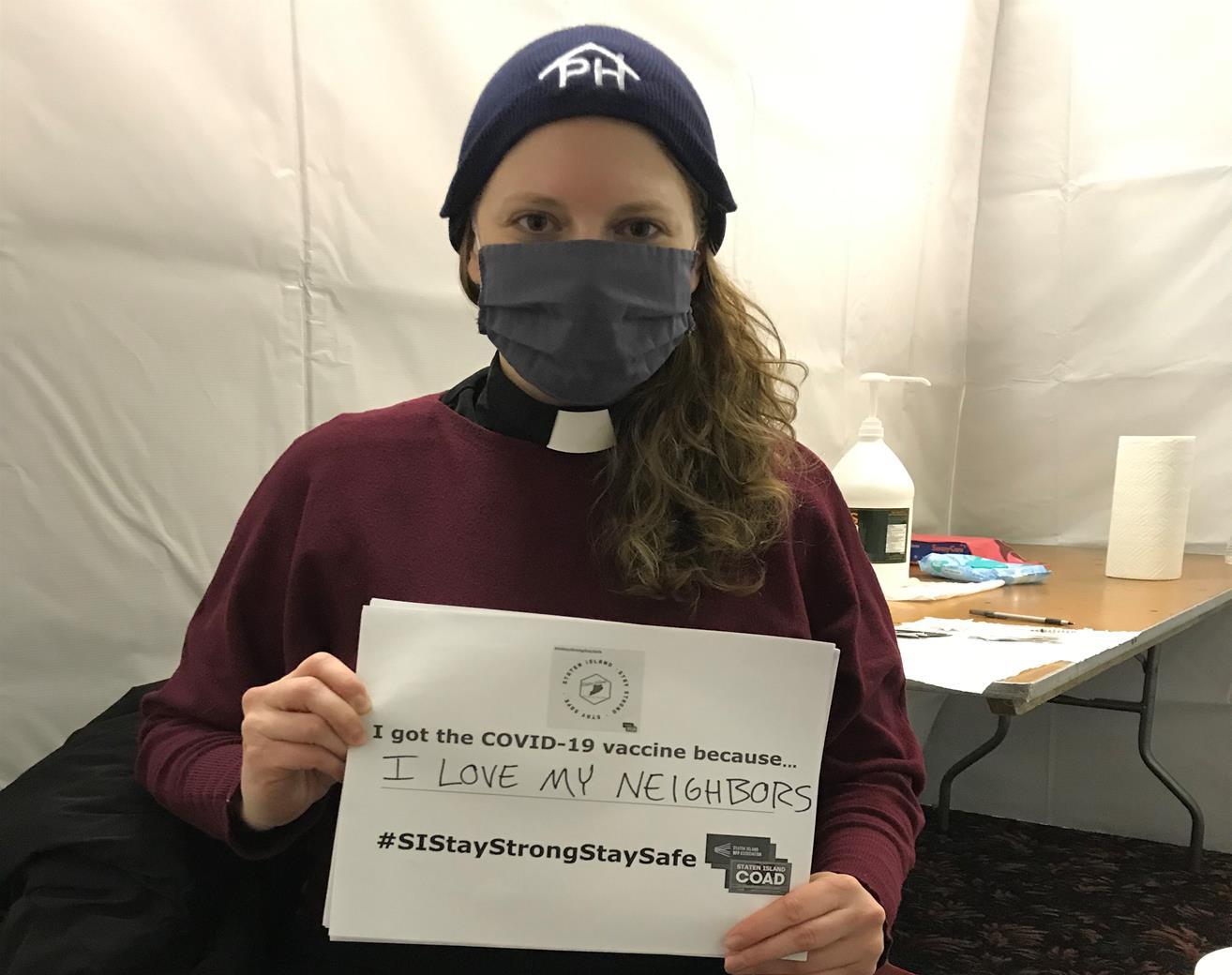By Kristin F. Dalton | kdalton@siadvance.com
STATEN ISLAND, N.Y. — Faith leaders on Staten Island have been making examples of themselves by getting vaccinated, and sharing it publicly, to help dispel myths and address vaccine hesitancy in their communities.
The Rev. Karen Jackson, co-chair of Staten Island Inter-Religious Leadership and director of community initiatives at Project Hospitality, recorded herself getting vaccinated and uploaded it to the group’s YouTube Channel.
Jackson shared a photo of her holding a sign that said, “I got vaccinated because I love my neighbors.”
Nearly one dozen other clergy members shared videos of themselves getting vaccinated and tested for COVID-19 on the Staten Island Inter-Religious Leadership’s YouTube channel.
Pastor Dr. Demetrius Carolina, Senior Pastor at First Central Baptist Church, said he wanted to serve as an example to a “very, very skeptical community” who he loves intently.
Faith leaders have been working with the city and state to organize vaccination pop-ups at respective houses of worship, many in Black and brown communities, and areas hardest hit by the coronavirus (COVID-19) pandemic.
They’ve participated in local and national Zoom calls with clergy, discussing strategies and concerns of community members.
The good news is that it’s been working.
“It has changed measurably,” Carolina told the Advance/SILive.com. “Black and brown folks who were previously against it are now seeking vaccinations.”
According to city data, 21% of Black New York City residents have received at least one dose of a COVID-19 vaccine as of April 9. On Staten Island, 22% of Black residents received at least one dose and 13% have been fully vaccinated.
CULTURAL, FAITH COMPETENCY HELPS
There is still reluctance, though; not everybody believes the vaccine will work, there are rumors of infertility and other myths, and deep-rooted mistrust in the government and health system.
“There is still some hesitancy, and rightly so, but people are seeing that others who were vaccinated are still here. They’re also seeing a rainbow, all hues of people, get vaccinated,” he said.
Personal testimonies have proven to be effective in combating hesitancy, they agreed.
“I think vaccine hesitancy is diminishing as time progresses. I think it makes a big difference when a trusted messenger like a clergy person shares why [they got vaccinated], and even mentions if it’s a faith-based reason,” Jackson said.
Carolina said he took his mother for both of her vaccine appointments. “And she was one of the people who didn’t want it,” Carolina said.
Cultural, faith, and spiritual competency has, in part, helped relay important information to community members and congregants. When respected leaders speak to their congregations it goes further than it would from an outsider.
CITY COULD BE DOING MORE
Although more Black and brown Staten Islanders – and city residents – are getting vaccinated at the vaccination efforts continues, many neighborhoods around the borough are underrepresented and underserved.
Both Jackson and Carolina agree that city could and should be doing more to reach vulnerable and hesitant populations.
“The first New Yorker to be vaccinated was a Black nurse and many [vaccination] ads were using people of color. I think I understood the meaning behind that, but I think it undermined [the city’s cause],” Carolina said.
The sole or primary use of Black and brown individuals could be seen as reminiscent of the Tuskegee Study.
Conducted by the Centers for Disease Control and the United States Public Health Service, the Tuskegee Study of Untreated Syphilis in the Negro Male was conducted between 1932 and 1972.
Black males were told they were being treated for “bad blood” and syphilis and incentivized with the promise of free health care to participate. Instead, the men received no treatment, were given experimental medications and procedures and were prevented from receiving additional medical care. Nearly half of the participants died.
“I honestly believe the city has good intentions; they are admirable to say the least but I don’t know that the efforts have been as successful as the intent,” Carolina said.
Mayor Bill de Blasio and the city’s Taskforce on Racial Inclusion and Equity began to address the inequities, identifying 33 neighborhoods that were hardest-hit by COVID-19.
On Staten Island, St. George, Port Richmond, and Stapleton were identified.
The taskforce said it would ensure the vaccine would be distributed equally within those neighborhoods.
Those 33 neighborhoods would be the first to have vaccination hubs and the city would partner with 200 community-based organizations (CBOs) and faith-based organizations to educate community members on the importance of getting vaccinated, dispel myths surrounding the vaccine, and provide education and resources.
The Vaccine for All campaign would build off of the Taskforce and “set of commitments to ensure the vaccine is accessible to priority populations, with the obligation to continually solicit feedback from hardest-hit neighborhoods throughout the distribution process.”
“There are a number of churches that could serve as pop-up vaccination sites that unfortunately have been missed and I’m not certain as to why,” Carolina said.
Jackson agreed, and said she’d like to see initiatives from the city to increase access to not only vaccination sites but scheduling appointments and further working to dispel myths. Until then, there’s a role for community members and people of faith to play.
“I think people of faith can help close that digital divide, those of us who have the time can help with appointments, maybe people who are bilingual, people who have internet access, people who can help with transport,” Jackson said.






